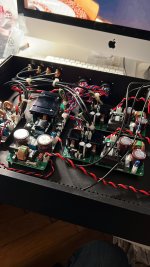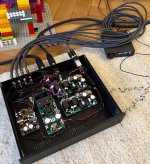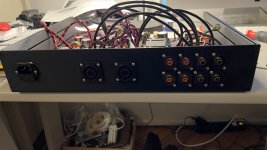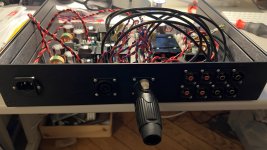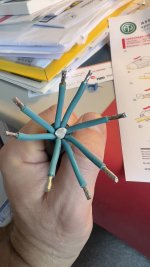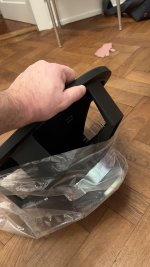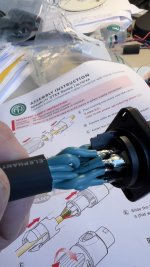I am working on a 5 way active open baffle speaker with sealed sub bass unit.
I will use mini DSP for the crossover. Because the mini DSP has only 8 channels I may use a passive crossover between 2 of the drivers.
So I will need 4 stereo amplifiers. I don't have much experience with higher end amplifiers so I am curious what experiences people have.
For the subwoofer class D seems obvious but I have heard the opinion somewhere that class A for a sub sounds noticably better. Is class D really ideal for subs or just economical?
On the other end I have a small AMT as super tweeter above 9kHz. Does a tube amp make sense here or will you only notice the difference vs. class D or A/B in the midrange.
So basically I have two questions.
1. Are certain amplifier classes better suited for high, mid or low frequencies?
2. How does required amplifier wattage scale with frequency. If I have a 1000w amp for my sub, a 200w amp for my woofer would a 3watt tube amp suffice for my super tweeter?
I will use mini DSP for the crossover. Because the mini DSP has only 8 channels I may use a passive crossover between 2 of the drivers.
So I will need 4 stereo amplifiers. I don't have much experience with higher end amplifiers so I am curious what experiences people have.
For the subwoofer class D seems obvious but I have heard the opinion somewhere that class A for a sub sounds noticably better. Is class D really ideal for subs or just economical?
On the other end I have a small AMT as super tweeter above 9kHz. Does a tube amp make sense here or will you only notice the difference vs. class D or A/B in the midrange.
So basically I have two questions.
1. Are certain amplifier classes better suited for high, mid or low frequencies?
2. How does required amplifier wattage scale with frequency. If I have a 1000w amp for my sub, a 200w amp for my woofer would a 3watt tube amp suffice for my super tweeter?
Last edited:
I am wondering similarly - what amp for my Danley SH50 MF drivers.
I've used 5w EL84 SET amps on compression drivers / horns. The very high efficiency mean they are just ticking over.
But the 5" Celestion cone drivers are new to me. The SET sounds okay and is no where near maxing out, but I wonder if I need more damping factor?
On sub bass (15" tapped horns), I use a Cerwin Vega 1800 watt silicon amp - weighs a ton and had nice high damping factor.
On LF 12" drivers I have a Crown 1002. It's quite sweet sounding, but I cross low at 325Hz!
So, ime if your tweeters are more efficient than your mids and bass etc you can use a flee power amp.
I've used 5w EL84 SET amps on compression drivers / horns. The very high efficiency mean they are just ticking over.
But the 5" Celestion cone drivers are new to me. The SET sounds okay and is no where near maxing out, but I wonder if I need more damping factor?
On sub bass (15" tapped horns), I use a Cerwin Vega 1800 watt silicon amp - weighs a ton and had nice high damping factor.
On LF 12" drivers I have a Crown 1002. It's quite sweet sounding, but I cross low at 325Hz!
So, ime if your tweeters are more efficient than your mids and bass etc you can use a flee power amp.
Class A all the way! But the topologies and purposes within that classification can vary greatly...
Single ended with resistor load, SE + choke, SE + constant current source, SE + bootstrapped negative resistance (SRPP, Aleph etc).
Push-pull? And is the output a buffer / current gain only, or a stage with voltage gain?
What's the strategy for distortion and keeping things linear? High gain / op-amp / discrete op-amp + high feedback and high damping factor? Low NFB / emitter degeneration or no feedback and probably a much lower damping factor? Which nicely leads to feedback strategy vs speaker type: voltage drive for bass, current drive for tweeters + active or DSP crossovers? Mixed mode (damping factor drops at higher frequencies + active filters) for wide-range? Or a low-ish damping factor and tune the bass response seperately (oversized boxes, etc)? All voltage drive + passive XOs? Zero NFB + high efficiency drivers used at low power?
Single ended with resistor load, SE + choke, SE + constant current source, SE + bootstrapped negative resistance (SRPP, Aleph etc).
Push-pull? And is the output a buffer / current gain only, or a stage with voltage gain?
What's the strategy for distortion and keeping things linear? High gain / op-amp / discrete op-amp + high feedback and high damping factor? Low NFB / emitter degeneration or no feedback and probably a much lower damping factor? Which nicely leads to feedback strategy vs speaker type: voltage drive for bass, current drive for tweeters + active or DSP crossovers? Mixed mode (damping factor drops at higher frequencies + active filters) for wide-range? Or a low-ish damping factor and tune the bass response seperately (oversized boxes, etc)? All voltage drive + passive XOs? Zero NFB + high efficiency drivers used at low power?
The ultimate thing to do, would be to run your favourite music (etc) through a Python script that applies the crossover slopes you want, and then gives you a statistical breakdown of how often it's going to clip vs power level. So you could fine-tune that without having to guess like everyone else does.2. How does required amplifier wattage scale with frequency. If I have a 1000w amp for my sub, a 200w amp for my woofer would a 3watt tube amp suffice for my super tweeter?
Last edited:
I had in the past years 10+ amp types and configurations.. finally i realized, it doesn’t matter as long as you use the right loudspeakers for your project and you set your crossover properly. A room measurement is obligatory and a good correction also! Dirac with only 1 measurement is the best. I’m finally really happy with my choice after almost 30 years of listening
I am working on a 5 way active open baffle speaker with sealed sub bass unit.
I will use mini DSP for the crossover. Because the mini DSP has only 8 channels I may use a passive crossover between 2 of the drivers.
So I will need 4 stereo amplifiers. I don't have much experience with higher end amplifiers so I am curious what experiences people have.
For the subwoofer class D seems obvious but I have heard the opinion somewhere that class A for a sub sounds noticably better. Is class D really ideal for subs or just economical?
On the other end I have a small AMT as super tweeter above 9kHz. Does a tube amp make sense here or will you only notice the difference vs. class D or A/B in the midrange.
So basically I have two questions.
1. Are certain amplifier classes better suited for high, mid or low frequencies?
2. How does required amplifier wattage scale with frequency. If I have a 1000w amp for my sub, a 200w amp for my woofer would a 3watt tube amp suffice for my super tweeter?
Wow you certainly have got a variety of responses!
I'll preface my response by saying I went 3-way active with my Maggies about 30 years ago. 7 years ago, I added a pair of subs - which required me to retire my analogue active XOs and use a miniDSP 10x10HD (giving 8 analogue output channels. Since then:
* I've moved on from the 10x10HD to a nanoDIGI (all-digital)
* and replaced my 3-way active Maggies with 2-way active 'zero baffle' spkrs.
My recommendations are (of course I don't know what drivers you are going to use - or the type pf music you listen to):
1. if you need to use a passive XO between 2 drivers - do this between your tweeter and the AMT.
2. use Class D on the sub. Because of their heat output ... you simply can't get a Class A amp which offers the power needed. You said you're thinking 1000w for the subs - great!
3. I would suggest a 300+w Class D would be an alternative to a 200w Class AB for your woofers.
4. tube amps - or Class A ss - would sound great for the mids & tweeters/AMTs ... but you may find you need a lot more power on your mids. In which case a good Class AB would be a good choice.
5. tweeters + AMTs (with a passive XO) will need more than 3w! 40w Class A ss or tube would be appropriate I suggest.
- Home
- Amplifiers
- Solid State
- Active crossover amplification class vs frequency
